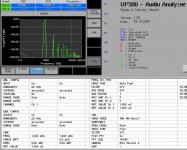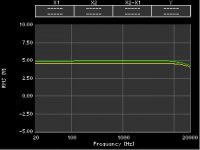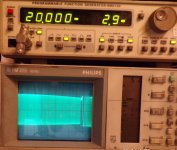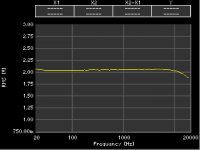Dunno - I might try the balancing scheme on a more modest scale just for the heck of it. Not with a big transmitting tube, though.
For SE, big power means big transformer - big bucks to get a good one. I was lucky to nab a pair of Sophia Electric transformers meant for an 845 application. I plan to marry them to some 813s in pentode mode for a monster partial feedback amp, though only about 30W in this case. Sophia has since come to their senses, and I've never seen any of the 845 transformers on E-pay ever again for the price I paid for mine.
Heyboer may be another alternative to Stangenes, and I hear they're quite reasonable. I haven't tried them myself, but everyone I've read of who has were pleased with the results.
For SE, big power means big transformer - big bucks to get a good one. I was lucky to nab a pair of Sophia Electric transformers meant for an 845 application. I plan to marry them to some 813s in pentode mode for a monster partial feedback amp, though only about 30W in this case. Sophia has since come to their senses, and I've never seen any of the 845 transformers on E-pay ever again for the price I paid for mine.
Heyboer may be another alternative to Stangenes, and I hear they're quite reasonable. I haven't tried them myself, but everyone I've read of who has were pleased with the results.
I never thought of Stangenes as a possible vendor for an audio transformer
I would caution asking anyone who has never built a tube OPT before to make a BIG tube OPT. The results can vary from mediocre to fireball.
I asked, and paid for a custom OPT to be wound by a vendor known on these forums for good OPT's, to make me a 5K ohm 50 to 100 watt SE OPT for use with the 833A tube. The transformer works, but has a notch in the response in a manner similar to the Hammond 1628 SE or 1628SEA.
I now know this to be caused by leakage inductance and winding capacitance forming a resonance. Both of these increase as the transformer size increases, but can be mitigated with extra, well planned interleaving.....how to get this right, comes from experience.
In my case I paid a fair price for time and material, and took what I got.
There was a thread here that started about 3 years ago where a member in Italy paid a lot of money for custom transformers for a big tube amp. After about 8 months the amp was ready for power up. Music flowed.....then smoke. One of the OPT's fried. See post #231 of this thread. Unfortunately we don't know the final results since the "account is disabled at the users request."
http://www.diyaudio.com/forums/tube...voltage-driver-ab2-operation-gu81m-tubes.html
We also know that Monolith Magnetics can build excellent BIG SE OPT's, but the shipping alone was more than I spend on my amps.
http://www.diyaudio.com/forums/tubes-valves/232484-midlife-crisis-my-833c-amp-build.html
I still have a pair of 1628SEA's and the big custom OPT, several 833A's, the power transformer out of a Harris radio transmitter, and the rest of the goodies, so now that I live where the heat radiated by a big class A amp can be a good thing.......some day.....
The thing is, if you have a second active device on the other side of the PP transformer, you might as well modulate it and have a PP amplifier.
How about just a resistor on the other side to balance the field in the core
Been there tried that.....My brain figured it out at about the same time I had finished the breadboarding.....DUH, if the resistor is sized right to balance the DC current, it will be just about the right size to dissipate about half of your audio power too! The resistor works equally well on AC as it does on DC.
What we need on the other side of a P-P OPT is a CCS. It draws a constant DC current, yet presents a high impedance ac AC. You can use a big fat expensive mosfet, or a pentode tube, or ANY suitable tube with a CCS chip in the cathode / grid circuit.
It is possible, and I have already built (on a tiny scale....) a single amplifier with a P-P output transformer that has a CCS in the tail of two pentode tubes. There is a switch that can disable the drive to one output tube in one position and switch a capacitor across the CCS in the other position. I was working on a variable control knob that allows for a blend between the two extremes, but that amp is a small (2W SE, 10 W P-P) guitar amp where distortion is a good thing.
One of the other posters here is building a 304TL amp using Heyboer output XFMRs. It may be interesting to follow his project as it develops.
http://www.diyaudio.com/forums/tube...t-schematic-redesign-eml-20b-alternative.html
http://www.diyaudio.com/forums/tube...t-schematic-redesign-eml-20b-alternative.html
Stangenes has actually built quite a few OPT for nutty engineers in Silicon Valley. I only suggest them because they're local and I went to technical school with the son of the owner. If we know that a self resonance is causing a dip in the audio band, we can specify a parasitic capacitance that will avoid it.
I think the current balancing thing isn't a great way to go for such a high b+. The 3KV supply is a real pain to generate. I have a PS transformer, but it's only good for 500mA DC. Maybe a microwave oven transformer would work, but they're single ended (one end of the output is connected to the core). If you have to use an ungapped transformer, how about a parafeed?
I think the current balancing thing isn't a great way to go for such a high b+. The 3KV supply is a real pain to generate. I have a PS transformer, but it's only good for 500mA DC. Maybe a microwave oven transformer would work, but they're single ended (one end of the output is connected to the core). If you have to use an ungapped transformer, how about a parafeed?
Electric chairs are only 2KV What happens when you are executed by electrocution? ? The Register The 3-500Z wants 3KV.
Maybe a microwave oven transformer would work, but they're single ended
Very old (1970ish) Litton and Amana microwave ovens had a conventional power supply with a huge and useful transformer. You can tell these ovens by the fact that it takes two people to pick them up.
The transformer in a modern microwave oven operates in a resonant voltage doubler circuit with the magnetron tube as the second diode. It is intended to operate with a HV cap in series that is about 1 uF. The circuit is designed to self current limit to protect the magnetron tube if the oven is operated without load (empty). The magnetron tube has a constant voltage drop (like a 2500 volt zener diode or VR tube) and draws a relatively constant current, when operated into a normal load (VSWR). This makes the Microwave Oven Transformer rather useless for anything that requires some degree of voltage regulation. Some people have knocked the magnetic shunts out of some transformers, to improve regulation, but it still doesn't work well.
I had collected several MOT's for experiments, and could not make a useful power supply with them. I thought that maybe they could be used for a SE OPT with a possible primary rewind. This didn't work well either since the maximum frequency is about 2 KHz. All my MOT's went to the scrap guy when I recently moved.
For a power supply, Hammond makes big transformers for use in ham radio transmitters. They have something suitable, and it is possible that a DIY ham radio amplifier could be found used, which could be parted out for power supply parts. With more and more hams (including me) turning to solid state amps, big old tube amps are turning up cheap, or sometimes free. Someone gave me a big DIY amp with a pair of 3-500Z's in it because the tubes were shot, and he didn't want to buy new ones, so he bought a new amp. I gave it to a fellow ham.
Antek has some toroids, each with a pair of secondary windings at 650, 800 or 950 volts. One of those should be useful for a rather deadly power supply. The OPT however, is still a sticky situation.
As stated by me in the past, and others currently, an amp of this magnitude is a major undertaking with potentially expensive, unpleasant, or lethal consequences for mistakes, which could be made by someone else, like the OPT winder. It should not be undertaken by someone that hasn't built big tube stuff before, and it must be understood that your entire investment, or a significant portion of it could be reduced to a pile of charred trash because of a simple oversight.
If you go down this road, have a fire extinguisher present at power up, some means of killing all power from across the room, and personal protection in case things blow up! I use a 1/4 thick piece of Lexan between me and the "experiment" when I'm not sure what's going to happen.
I just finished building an 833-A SET by way of modification of a tri-amp for a pair of GR Research OB-7 speakers. I have always wanted something exhibitionist and wild looking but functional. I do not need more than 75 watts because I am driving the tweeters with a 245 and the mid-range speakers with another 245. Both 245s are driven by a very low impedance output choke loaded mu-follower 6SN7 that directly couples to the 245s and the 6SN7s are cathode biased with pairs of series blue LEDs that replace the resistor and 220 micro-farad capacitors. I found that by connecting the 245 that drives the output transformer (5 K) to the mid-range speaker to a Hammond interstage transformer or 5 K that goes to the grid of the 833A I get no change in sound or AC voltage to the mid-range, the mid-range 245 has low enough output impedance to drive both the speakers and input transformers to the grid of the 833A. I added a 1K pot to turn down the input volume to the 833A input transformer so that its bass could be matched in volume to the rest of the system.
I found the Hammond 1642SE transformer a beautiful match to drive the woofers and also to sound spectacular if I drove full-range speakers as an experiment. The grid can be run at ground or zero bias so the secondary of the driving transformer connects between ground and the grid.
I only use 1000 volts through the 1642SE transformer to the 833A anode and the power supply has to be in a Plexiglass cage for safety so nobody touches any high voltage.
The cathode heater is run through a rectifier, 0.1 ohm 25 watt resistor, and a 4.5 Farad automotive digital capacitor that has to be kept pre-charged when the amplifier is not in use. This is what it takes to get hum-free audio, forget about hum cancelling pots or center-tapped AC.
I hope this helps.
I found the Hammond 1642SE transformer a beautiful match to drive the woofers and also to sound spectacular if I drove full-range speakers as an experiment. The grid can be run at ground or zero bias so the secondary of the driving transformer connects between ground and the grid.
I only use 1000 volts through the 1642SE transformer to the 833A anode and the power supply has to be in a Plexiglass cage for safety so nobody touches any high voltage.
The cathode heater is run through a rectifier, 0.1 ohm 25 watt resistor, and a 4.5 Farad automotive digital capacitor that has to be kept pre-charged when the amplifier is not in use. This is what it takes to get hum-free audio, forget about hum cancelling pots or center-tapped AC.
I hope this helps.
its one old tread but i see only now
the hammond 1642se its very good i use for 304TL 1K2V @ 02/025A
1%THD @28W and over 75W A2
304TL SE - Google Drive
linearity its not bad and low end great
the hammond 1642se its very good i use for 304TL 1K2V @ 02/025A
1%THD @28W and over 75W A2
304TL SE - Google Drive
linearity its not bad and low end great
Attachments
will probably take a crude measurement next day off out of curiosity. There is a more interesting measurement I took. Because the curves in the chart fr the 833A are too crude to tell at what plate voltages and grid bias voltages the 833A is most linear I used some household batteries and I already have a DC milliammeter between the cathode and ground.I found that I can pull the cap plug off the grid. Of course the plate cap has a safety collar to make it impossible to touch it for the obvious reason of 1000 Volts on it. Connecting the battery between the grid cap and ground and getting the same increase in cathode current as the decrease I get when I reverse the battery polarity is a poor man's way to verify the 833A is linear at zero applied grid voltage. This is extremely convenient because I don't need a grid bias supply and I don't have such a supply in the signal path for the grid input. The WAVAC833A which costs $350,000 uses positive grid bias if I read correctly what little information there is about it. I also doubt for $350,000 you get polypropylene filter capacitors in the 1000 Volt power supply instead of electrolytic capacitors in such an amplifier you can build yourself for about $2000. I also prefer to drive the grid with the more pulchritudinous 245 triode instead of a KT88 and I want my choke-loaded 6SN7 twin triode directly coupled to the grid of my 245.
Overall, I think the Hammond 1645SE is as good as any exotic Japanese transformer; Hammond is an underrated brand.
Overall, I think the Hammond 1645SE is as good as any exotic Japanese transformer; Hammond is an underrated brand.
Eh, I wouldn't be as easily convinced that the Hammond is up to the level of performance of the higher end iron (personally I do not consider Japanese output transformers "high end"). 100 watt SE transformers are going to exceed your $2000 budget pretty quickly...
Depending on what you're up to, the #45 may have trouble with the peak current demands of an 833's grid and certainly will leave a lot to be desired in the transconductance department compared to a KT88.
If you directly couple a 6SN7 to your #45, zero biasing your 833 is going to be quite a challenge.
Depending on what you're up to, the #45 may have trouble with the peak current demands of an 833's grid and certainly will leave a lot to be desired in the transconductance department compared to a KT88.
If you directly couple a 6SN7 to your #45, zero biasing your 833 is going to be quite a challenge.
I am sure the 45 does not drive the 833A grid very hard, but since it can play in my little house too loud, it is good enough for me. The distortion might not be noticeable with the KT88 but it is less because I am not driving the 833A very hard. Also, the Hammond transformer is not being driven very hard and with only about 120 ma when it is rated at 300 ma it is far from core saturation.
But most important, it sounds to me more like a live orchestra driving Magnepans.
But most important, it sounds to me more like a live orchestra driving Magnepans.
I built a high power SET amp with the 1642 to see how good/bad this is for myself. My source impedance driving the transformer is about 1.4K, so I expected reasonable results into a 5K output transformer, but I ended up with this instead:

This was so bad that I contact Hammond to ask if perhaps they could offer a different part to replace these, then they started making excuses.

Here's the same amp with a Monolith output transformer.
Through my communications with Hammond, I learned that they do not understand the difference between source impedance and the impedance reflected by the output transformer. When I said that I had a 1.4K source and a damping factor of about 3, the QC guy said I must have a 3 ohm load on the output of the amp and a 1.4K source impedance, yikes!
I believe when they are measuring something like the 1642, they are driving it directly with their audio analyzer that has a selectable 25 or 600 ohm output impedance, and then posting that their source impedance is 10K.
This was so bad that I contact Hammond to ask if perhaps they could offer a different part to replace these, then they started making excuses.
Here's the same amp with a Monolith output transformer.
Through my communications with Hammond, I learned that they do not understand the difference between source impedance and the impedance reflected by the output transformer. When I said that I had a 1.4K source and a damping factor of about 3, the QC guy said I must have a 3 ohm load on the output of the amp and a 1.4K source impedance, yikes!
I believe when they are measuring something like the 1642, they are driving it directly with their audio analyzer that has a selectable 25 or 600 ohm output impedance, and then posting that their source impedance is 10K.
- Home
- Amplifiers
- Tubes / Valves
- Anyone tried the Hammond 1642SE in a BIG SE amp?



